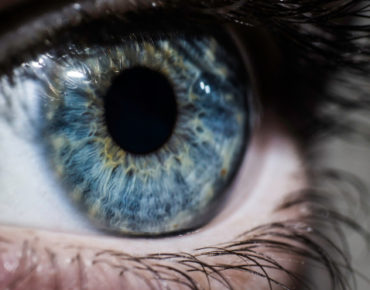From ‘Retinator’ to Visionary: AI for Automated Retinopathy Diagnosis

shutterstock 1309851100
The Iowa Informatics Initiative (UI3) Artificial Intelligence (AI) Symposium was Friday, February 15, 2019 in the University of Iowa (UI) College of Public Health building. UI3 Director Greg Carmichael and UI Associate Dean for Research and Director of the Engineering Initiative for AI Milan Sonka (UI-College of Engineering) welcomed participants. More than 200 informatics professionals from UI and regional industries registered for the event that included eight invited talks, a poster session, luncheon and co-located tours of the AI and engineering labs. A special AI session of “WorldCanvass” was held February 12.
Symposium keynote speaker Dr. Michael Abràmoff is the Robert C. Watzke, MD, Professor of Retina Research Professor of Ophthalmology and Visual Sciences in the UI Carver College of Medicine (CCOM); as well as an internationally-renowned physician, scientist and fellowship-trained specialist. He holds master of science degrees in medicine and biomedical informatics, and a medical doctorate degree from the University of Amsterdam; plus, a doctor of philosophy degree in biomedical imaging from the University of Utrecht in the Netherlands. With 13 patents under his belt, he has authored more than 300 papers that have been cited more than 26,000 times.
Abràmoff joined the UI-CCOM faculty in 2004, and has spent decades perfecting instrumentation and algorithms used to detect diabetic retinopathy, a leading cause of blindness that can be prevented with early diagnosis and treatment. Diabetic retinopathy affects more than 493 million worldwide and is the primary cause of blindness in the U.S. working-age population. The numbers are increasing with the obesity epidemic and subsequent uptick in cases of type-two diabetes.
Beginning with his research on neural networks from 1989, by 2000 Abràmoff had described how algorithms can detect retinopathy. With a primary interest in preventing blindness, he went on about the business of perfecting the algorithms and founded his company, IDx. He presented his plan for approval of autonomous AI for diabetic retinopathy diagnosis to the U.S. Food and Drug Administration (FDA) in 2010.
The FDA didn’t support Abràmoff’s first proposal, and few others in 2010 understood AI’s potential, in general. One colleague-editor granted him the moniker, “The Retinator.” “All of this happened around the time I was going for tenure at UI,” he said.
But that didn’t stop him; with IDx, he kept pushing and perfecting the AI system under intense discussion with the FDA. From the beginning, he was concerned about bias in AI algorithms, and wanted to ensure that results were consistent across all ages, races and ethnicities; retinas vary in color and tone depending on the level of melanin present in the patient. As a practicing physician, it was obvious to him that biomarkers used in the clinic did not have such bias. Ensuring the most inclusive and equitable outcomes required biomarker algorithms with a broad range of imaging files and access to more computational power; a process that required years to complete with the help of Andreas Wahle (Iowa Institute for Biomedical Imaging), UI-Information Technology Services (ITS) Research Services’ Advanced User Support; and the Helium and Neon supercomputing clusters.
As a pioneer in autonomous AI systems, Abràmoff realized that he would have to train his peers, policymakers, and machines at the same time. Technical barriers would be more easily overcome than human-interfaces; antiquated assessment frameworks stood in his way. With his company, IDx, he developed an awareness campaign based on a platform of transparency and patient safety, published peer-reviewed papers and lobbied to establish trust and confidence in AI among authorities who certify the safety and quality of U.S. health care. In some cases, the processes were originally established to oversee the actions of humans (physicians) and lacked an apparatus to consider autonomous AI. “It helped that a scientist from Harvard published a study about machine learning bias about the same time; their work validated what I was doing,” he said.
His persistence paid off in 2018 when the FDA approved clinical trials for the use of IDx-DR—a fully-autonomous AI system for the early detection of diabetic retinopathy—by primary care physicians. In fact, it is the first fully-autonomous diagnostic AI system to be cleared by the FDA. IDx-DR is being used on patients around the country at multiple clinics, and more will be deployed in the coming weeks. The work is managed by Abràmoff’s startup that employs over 50 people in Coralville, Iowa.
IDx-DR can be administered by someone with a high school education. Machine-read and delivered test results are available within minutes versus months as is often the case with traditional diagnostic procedures and workflows. Since untreated diabetic retinopathy progresses toward blindness over time, the rapid turnaround is transformative. Human ophthalmological specialists must read traditional tests, but few communities have an ophthalmologist, and consultations are costly. Therefore, IDx is especially promising for those who live in rural and impoverished regions that lack access to specialists, and where obesity, type-two diabetes and blindness occur at higher rates.
“So, today the press reports nice things about us,” he said, and added, “General Electric even said we’re one of the five coolest things on earth!”
Sonka asked Abràmoff why he would put so much effort into replacing well-paid specialists, adding, “Didn’t you reduce your bread-and-butter?” “No,” said Abràmoff. “Physicians make more money treating patients than from diagnostics. IDx-DR will reach more people and diagnose more cases that we will then treat1; fewer will go blind and everybody wins. We just altered the patient-care workflow for the better,” he added.
During a break, medical student Marcus Toral, featured above (right), also paused to consider employment security. He’s in his fifth year of training to become an MD/PhD specialized in ophthalmology. Toral said, "Medical AI is a scary thing to a lot of physicians and medical students. ‘Will I be replaced?’ is an ever-pervasive thought when it comes to automation. But it’s important to look at the evidence, put patients first and focus on how AI can be developed to support over-burdened medical professionals; Dr. Abràmoff’s technology does just that."
Symposium participant Dayton Trent (UI College of Pharmacy), also featured above (center), remarked about the time it took for this AI solution to progress with the FDA. He said, “Dr. Abràmoff’s presentation made me realize that anything is possible and that great things do come to those who wait and have the patience to persist for eight years!”
Abramoff's Advice for Developing AI-empowered Innovation
“Autonomous AI is often but not always the right solution,” Abràmoff said, and added, “It’s important to seek expert advice from UI3 and domain-based communities of practice. Understand what your peers are doing; educate yourself,” he said.
Tips for Influencing Decision-Makers
“In order to foster governance (FDA/Federal Trade Commission) approval, you must be fully-transparent about your product’s safety, efficacy and equity,” he said, and emphasized the importance of documenting preregistered research outcomes in peer-reviewed journals. “Physicians and the public also want to know that it was the outcome of a well-developed study; why the system was built a certain way, and how the process of discovery unfolded over time,” he added.
Elizabeth Leake is communications manager of UI3.
- “Pivotal Trial of an Autonomous AI-based diagnostic system for detection of diabetic retinopathy in primary care offices,” by Michael J. Abràmoff et al., published in the 2018 (Nature Partner Journals) npj-Digital Medicine, pages 38-40: "The results of this study show that the AI system in a primary care setting robustly exceeded the pre-specified primary endpoint goals with a sensitivity of 87.2% (>85%), a specificity of 90.7% (>82.5%), and an imageability rate of 96.1%. Sensitivity is a patient safety criterion, because the AI system’s primary role is to identify those people with diabetes who are likely to have diabetic retinopathy that requires further evaluation by an eye care provider. Previous studies have shown that board-certified ophthalmologists that perform indirect ophthalmoscopy achieve an average sensitivity of 33%,27 34%,28 or 73%9 compared to the same ETDRS standard."











